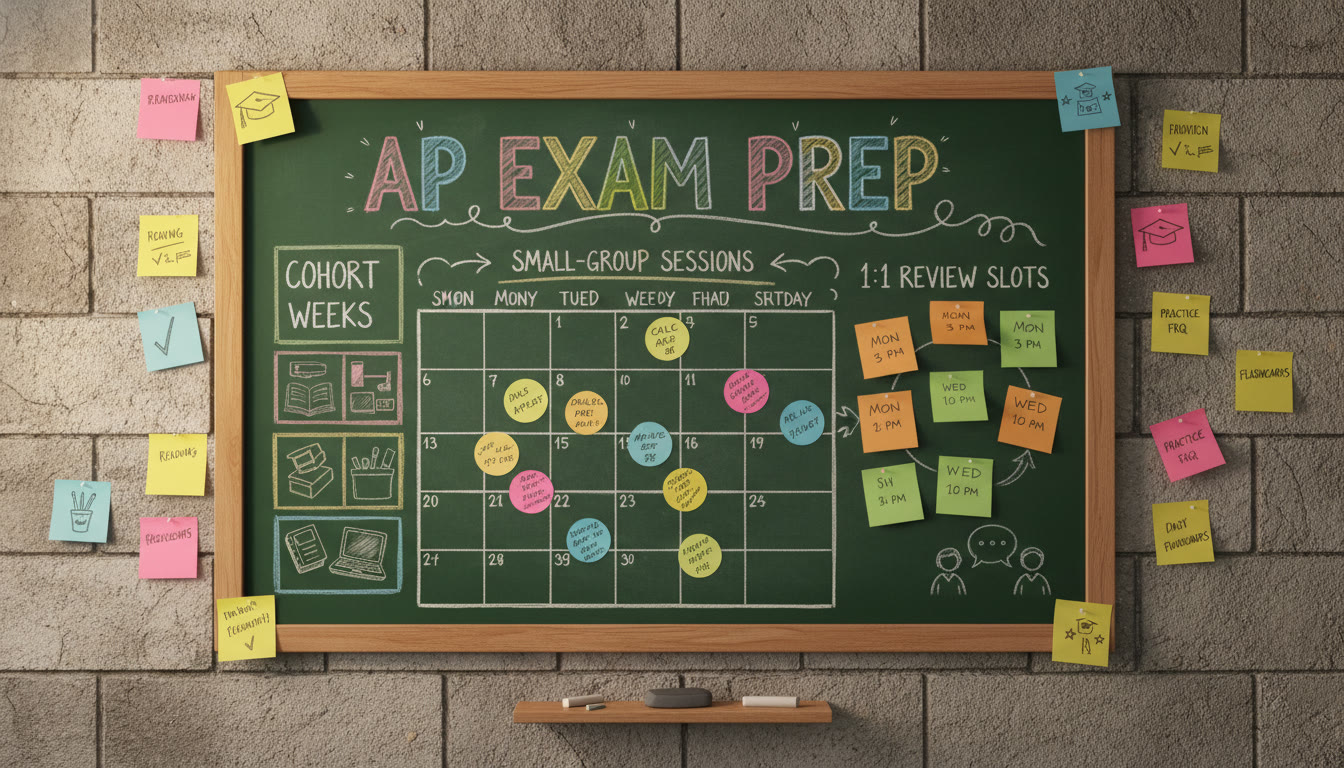Introduction: Why the Right Tutoring Model Matters for AP Students
Watching your child wrestle with AP concepts—long physics problems, dense history prompts, or the maze of calculus—brings up a practical question: what kind of tutoring actually produces results? For parents, choices usually boil down to three broad models: one-to-one tutoring (1:1), small-group tutoring, and cohort-based programs. Each promises gains, but they come with different time investments, price tags, and learning dynamics.
This article breaks down how those models work, how they affect outcomes, what you can expect to pay, and how to choose the best fit for your child. I’ll weave in examples, comparisons, and real-world context drawn from classroom experience and tutors’ best practices. Where fitting, I’ll mention how Sparkl’s personalized tutoring can support different needs with 1-on-1 guidance, tailored study plans, expert tutors, and AI-driven insights—without making that the centerpiece.

Quick Overview: The Three Core Models
Before we dig deeper, here’s a quick snapshot of each model so you can anchor the finer details that follow.
- 1:1 (One-to-One) Tutoring — Personalized, flexible, and focused entirely on the student’s needs. Best for addressing specific weaknesses and accelerating mastery. Highest cost per hour.
- Small-Group Tutoring — Typically 2–6 students. Balances cost and personalization. Encourages peer learning and can target common gaps efficiently.
- Cohort-Based Programs — Larger groups, structured curriculum, often time-limited (e.g., 8–12 weeks). Economical, consistent, and socially motivating—best for students who thrive with routine and peer accountability.
What Parents Really Want to Know: Outcomes, Not Labels
Labels are helpful, but parents care about outcomes: higher AP scores, deeper conceptual understanding, stronger study habits, and whether students feel confident on exam day. Costs matter too—because you want a return on investment.
Here are the outcome dimensions to use when evaluating any tutoring option:
- Academic Improvement: Change in AP practice test scores, in-class grades, and mastery of core concepts.
- Skill Transfer: Ability to apply problem-solving strategies to new questions (not just memorized answers).
- Study Habits: Time management, note-taking, and independent practice routines.
- Exam Performance: Actual AP score, but also test-day confidence and pacing.
- Cost Efficiency: Dollars spent per unit of measurable improvement (e.g., per point increase on a practice or official AP exam).
Deep Dive: 1:1 Tutoring — Precision and Personalization
What 1:1 Does Best
One-to-one tutoring is the surgical tool of academic help. The tutor diagnoses specific misconceptions, tailors explanations to the student’s learning style, adjusts pacing instantly, and zeroes in on the highest-impact gaps. For AP tests—especially math-heavy or writing-intensive subjects—this level of attention translates into rapid progress when implemented well.
Typical Structure and Activities
- Initial diagnostic test and skill-mapping to identify weak standards.
- Lesson-by-lesson scaffolding: concept review, targeted practice, error analysis.
- Homework review and tailored practice sets focused on recurring errors.
- Exam strategy coaching: pacing, rubric-aware writing practice, and section-specific traps.
Pros and Cons
- Pros: Highly personalized, flexible scheduling, quick correction of misunderstandings.
- Cons: Most expensive per hour; effectiveness depends heavily on tutor quality and chemistry with the student.
When to Choose 1:1
Choose 1:1 when a student has specific deficits that need concentrated attention (e.g., weak algebra foundations for AP Calculus), when they have high goals (like aiming for a 4 or 5 and need precise coaching), or when learning differences demand customized approaches. It’s also ideal in the final weeks before the AP exam for intense, targeted review.
Small-Group Tutoring — The Middle Road
How Small Groups Work
Small groups, often 2–6 students, combine peer learning with personalized attention. Tutors can rotate focus among students during a session, use shared problem sets, and keep costs lower than 1:1 while preserving some adaptability.
Learning Dynamics and Benefits
- Peer explanation—students often learn well by teaching or defending their reasoning to classmates.
- Social motivation—healthy competition and camaraderie can increase practice time.
- Economy—lower cost per student while still allowing diagnostic attention.
Pros and Cons
- Pros: Cost-effective, social reinforcement, tutor can address common misconceptions for multiple students at once.
- Cons: Less individualized than 1:1; if group composition is mismatched (very different levels or commitment), progress can slow.
When Small Groups Shine
Small groups are great when students are at similar levels and working toward similar goals—such as a group of classmates all taking AP US History who want guided essay practice. They’re also a sensible choice if you want some personalization without the full cost of private tutoring.
Cohort-Based Programs — Structure at Scale
What a Cohort Looks Like
Cohorts are larger, curriculum-driven programs that run on a fixed schedule—think an 8-week, weekly class dedicated to AP exam prep with a set syllabus, regular quizzes, and a final cumulative practice exam. They emulate a class but with added exam-focused strategies and consistent pacing.
Strengths and Limitations
- Strengths: Predictable schedule, community feel, accountability, and excellent value for money. Good for students who thrive in structured environments.
- Limitations: Lower personalization; students behind by several grade levels may struggle to keep pace. Less flexibility for individualized remediation.
Best Fit
Cohorts are ideal for motivated students who need a steady regimen and benefit from cohort momentum—e.g., students who want weekly discipline and exam strategies but don’t need deep remedial work. They’re also useful for early-season preparation when building broad coverage ahead of intense end-of-year review.
Cost vs Outcome: Practical Comparison
Let’s look at typical cost brackets and expected outcomes, acknowledging that exact prices vary by region and provider. Consider this a decision framework rather than a price list.
| Model | Typical Hourly Cost | Best Outcome | When It’s Worth It |
|---|---|---|---|
| 1:1 Tutoring | High | Rapid, targeted gains; conceptual mastery | Major deficits, aiming for top scores, learning differences |
| Small-Group (2–6) | Medium | Good balance of personalization and cost-effectiveness | Students with similar levels and commitment |
| Cohort Programs | Low to Medium | Consistent progress and accountability | Structured learners and budget-conscious families |
Note: “Cost” and “Outcome” are correlational but moderated by tutor quality, student effort, and timing. The most expensive option won’t guarantee the best outcome if the student isn’t engaged or the tutor isn’t effective.
How to Measure Return on Investment (ROI)
Parents should look for measurable indicators over anecdotal reports. Here are practical ROI measures you can track:
- Baseline and follow-up practice exam scores (use official or reliable practice materials).
- Weekly skill checks or quizzes showing consistent error reduction.
- Tracking time-on-task and homework completion—improvements in study habits are a durable ROI.
- Rubric-based essay improvements for AP Lang or History (e.g., thesis clarity, evidence use).
Example: If 10 hours of a tutor’s time increases a student’s AP practice score by 1 full point, many parents see that as a positive ROI, especially if it translates to college credit or admission advantages.
Case Studies: Real Families, Real Decisions
Case 1: From 2 to 4 in AP Calculus (1:1)
Sam struggled with limits and derivatives early in the year. A focused 1:1 plan used diagnostic testing, remedial algebra reinforcement, and scaffolded problem-solving. Over a three-month period, weekly sessions plus targeted practice pushed Sam from a 2-level practice average to consistent 4-level performance. The personalized pacing made all the difference.
Case 2: APUSH Group—Essay Skills and Community (Small Group)
Three classmates formed a small group to prepare for AP US History. The tutor used timed DBQ practice, peer review cycles, and essay rubrics. Because they were on the same teacher’s syllabus, the group’s targeted practice produced improved timed essay scores and higher classroom participation.
Case 3: Cohort for Winter Review (Cohort)
Lena enrolled in an eight-week cohort program covering AP Biology review. The program offered weekly quizzes, lab-skills refreshers, and a practice exam at the end. Lena benefited from the steady schedule and the test-day simulation; she wouldn’t have been as disciplined with self-study.
Blend and Flexibility: You Don’t Have to Pick Only One
Smart families often combine models. A common hybrid is cohort courses early in the year to build routine and breadth, supplemented by 1:1 sessions for targeted remediation in the months before the exam. Small-group sessions can replace some 1:1 hours for steady practice, keeping costs in check while maintaining progress.
For example, your child might attend a weekly cohort class from September through March to cover the curriculum, join a small weekly study group for peer review, and add two 1:1 sessions in April and May to tighten pacing and address stubborn gaps. This layered approach often produces the best balance of cost and outcome.
How to Evaluate Tutor Quality — Questions to Ask
Quality matters more than model labels. Ask prospective tutors or programs these practical questions:
- What diagnostic tools do you use to identify gaps?
- Can you show examples of growth metrics or case studies?
- How do you adapt lessons to different learning styles?
- How will progress be measured and communicated to parents?
- Do you provide practice exams and graded feedback aligned to the AP rubric?
- How do you build independent study skills so the student isn’t dependent on tutoring forever?
Red Flags to Watch For
- Vague promises like “guaranteed 5” without documented, individualized plans.
- High turnover among tutors, which signals inconsistent instruction.
- Lack of diagnostic testing or measurable goals.
- Overemphasis on tips and tricks without addressing conceptual understanding.
Practical Checklist for Parents
Use this short checklist when choosing and monitoring a tutoring arrangement:
- Start with a diagnostic test and a written, time-bound plan.
- Define target improvements (e.g., increase practice exam score by one point in three months).
- Schedule regular check-ins—every 4–6 weeks—with the tutor to review progress.
- Ensure homework and practice are tracked; independent practice should grow over time.
- Allocate last 6–8 weeks before the AP exam for focused 1:1 or targeted sessions if possible.
How Sparkl’s Personalized Tutoring Fits In
For many families, a program that offers flexibility is ideal. Sparkl’s personalized tutoring model blends expert 1-on-1 coaching with data-driven planning—using tailored study plans and AI-driven insights to focus practice where it matters most. That means your child can get the individualized attention of 1:1 when needed, participate in small-group lessons for collaborative learning, and join cohort-style review modules for consistent pacing and accountability. The combination allows parents to manage costs while keeping outcomes high.
Wrapping Up: A Roadmap for Your Decision
Choosing between 1:1, small-group, and cohort tutoring doesn’t have to be a binary decision. Start with these steps:
- Identify the student’s current level with a reliable diagnostic.
- Clarify goals: target AP score, timeline, and preferred learning style.
- Compare models against those goals and your budget—remember hybrids are often best.
- Vet tutor quality and expect measurable progress indicators.
- Adjust the plan as you see measurable gains or new gaps emerge.
Investing in tutoring is investing in your child’s confidence and future options. The most effective approach is the one that fits your child’s needs and keeps them motivated. Whether you opt for the precision of 1:1, the camaraderie of small groups, or the structure of cohorts, pairing the model with high-quality instruction, consistent practice, and clear measurement will get you the best return.

Final Tips for Parents
- Be patient—meaningful growth in AP subjects often takes 8–12 weeks of consistent practice.
- Encourage balance—emsure your child gets adequate sleep, nutrition, and downtime; cognitive performance is holistic.
- Celebrate small wins—improved practice scores, better essays, or faster problem-solving all matter.
- Communicate—regularly check in with your child about what’s helping and what feels taxing.
Need a Starting Point?
Begin with a short diagnostic, set a realistic target, and choose a tutoring structure that aligns with the timeline and intensity required. If you prefer flexibility, consider programs that provide a path to scale from cohort participation to small groups or 1:1 support as needs change. That way, your child gets the right help at the right time—without paying for more than they need.
Good luck—your involvement and thoughtful choices are among the most powerful factors in your child’s AP success.
























No Comments
Leave a comment Cancel